Chiller Fault Finding. In this article we’re going to be looking at chiller faults and troubleshooting them. This will cover some of the most common types of faults you might come across in the industry.
We’re going to cover high pressure on the discharge, low pressure on the discharge, low pressure on the suction line, high pressure on the suction line, some general electrical issues you might come across as well as a few other issues.
Scroll to the bottom to watch the YouTube video tutorial on chiller fault finding
Warning
Chillers are very expensive and they can be quite dangerous. So if you are not qualified, competent or authorised to work on them in your building or your client’s building, then please do not. Seek professional help instead.
Top Tip
Something to note: On the display unit of the chiller, or on the BMS units, an error code should display if a fault is detected. Write this code down and check with the chiller manufacturer, they should have a maintenance guide which will provide you information for the cause of the fault.
High pressure discharge
High pressure discharge is very common in water cooler chillers, and it’s nearly always caused by bad water treatment regimes. Make sure your building or your clients building has a strict water treatment regime in place. Especially when you have open cooling towers.
Minerals and dirt will be absorbed from the air, into the condenser water loop. This will then flow around the system and begin to the clog the pipes and the chillers heat exchanger. So it basically starts to insulate the internal surfaces of the chillers condenser which will prevent the chiller from being able to transfer it’s rated thermal energy.
A similar scenario occurs with air cooled chillers where the condensers external surface becomes covered in dust and dirt. Over time, the the air cooled chiller condenser will become coated in a film of dirt. So you want to make sure that all the tubes and fins are cleaned regularly. But remember that the tubes out there are full of refrigerant and they are very delicate, so be very careful when you do these. Use light brushes and also some comb fins as well.

Another common issue, especially with air cooled chillers is a reduction of airflow over the condenser and that’s usually where some some debris has blocked part of the condenser, or the fans, and so not enough air is flowing through the condenser to take all the unwanted heat away. It could also be that one of the fans has stopped working or is behaving erratically, so you want to go up there and visually check that they’re clean, it’s free from obstructions and that the fans were working.
High pressure discharge faults can also be caused by a reduction of water flow through the condenser. Firstly you should check the systems valves, strainers and pumps to make sure they’re all working and allowing the correct flow rate to pass through. If you do not hold a log of the correct flow rates then locate the systems commissioning data, which should have been issued to the building manager when the chillers were installed and tested.
Additionally high pressure discharge can occur when the return condenser water, on a water cooled chiller, is returning from the cooling tower too hot. Check the cooling towers and make sure that the fans are working, the cooling tower bypass valves are properly aligned and that the water isn’t just bypassing the cooling tower and returning to the chiller.
It could also be caused by a partially closed discharge shut off valve on the chiller. It’s slightly uncommon for this to happen, but it could have been knocked during maintenance etc.
With air cooled chillers, it could be that the outside ambient air temperature is a above the condenser capabilities. So it simply can’t work in these conditions. You have to wait for it to cool down or adjust the parameters and the set points of the chiller. Also, make sure that you check with the manufacturer that it is capable of doing so before doing that. An option is to spray water over the condenser although this will lead to mineral build up on the fins and the condenser will rest much quicker so this is a last resort option.
Another fairly common issue which will cause high pressure faults is that the chiller has been overcharged with refrigerant. Go around the chiller and check all the pressure, temperature and sight glasses installed, as well as the BMS readings. It could also be that a non-condensable material or fluid has entered into the refrigerant loop. Make checks on the chiller and listen for noises. If it is caused by foreign matter then the system will need to be surged.
Lastly, if none of these resolve the issue, then check that the pressure switch isn’t fault!
Low Pressure Discharge
One issue that causes low pressure discharge is if the suction valve is partially closed, so do check that. It’s fairly uncommon but it could happen.
Refrigerant undercharge can cause low pressure discharge. You will need to make checks on the system that it has has enough refrigerant charge. If you suspect that this is the problem, then it needs to be topped up.
Another issue could be that the ambient air temperature is just too low. An air cooled chillers may not be able to operate in these conditions and there’s not much you can do about that. You really have to reprogram the system and check with the manufacturers that this is possible to do. As a last resort you could heat the air, purposely cause re-circulation or direct the buildings ventilation extract air to it’s direction. Do not use kitchen extract air!
The most common issue for low pressure is going to be a dirty or an obstructed evaporator. So check there’s nothing blocking this.
Low Suction Pressure
This could be down to a low refrigerant charge. Check around your system for signs of this and top up if needed. Don’t forget to check for leaks as well. If the pressure become too high in the chiller, it might have vented through the safety relief valves.
One of the more common issues with this is going to be a blocked expansion valve. So you might have to clean this and or replace it if needed. It could also be that there’s a reduction of flow into the evaporator. So again, you want to check all the valves, bypass valves and pumps in the system to make sure that they’re all working. If you don’t know what the flow rate of water should be through that chiller or the evaporator then your commissioning data from when it was first installed and commissioned.
You should also check the filter drier and the strainer. If they’re obstructed then clean these or replace them.
Low suction pressure could also be caused by the condenser water temperature being too low. So you want to have a look at the set points and the design criteria for that. You might have to adjust the bypass valves around the cooling towers to make sure that the waters coming back at the correct temperature.
High Suction Pressure
Now if you have a high pressure warning on the suction line, then three main things that can cause this.
Excessive load is probably the main one and that is where the cooling load is just too much for the chiller to handle. You want to reduce that if possible. Or spread this over to other chillers and cooling equipment.
The expansion valve could be overfeeding refrigerant. So you want to check this as well. If this happens then you’ll probably have to replace the expansion valve, but obviously do try to adjust the superheat set point first.
The chiller could also be overcharged with refrigerant, so you want to check your set points, temperatures and pressures around the system and then remove (recover) some of the excess refrigerant. This must be carried out by a qualified specialist.
Electrical Faults
An unbalanced voltage supply to the chiller can cause faults. You want to measure your voltages on each of your phases to make sure that they are balanced. It could indicate that there’s a problem with the electrical switch gear within your building or power quality issues.
A more common problem with chillers is a fluctuating voltage or current. That’s usually going to be affected by other equipment which is connected onto the same circuit as the chillers which cause fluctuations or distortions in the voltage and current wave forms. A sudden large inrush current to another plant item on the same circuit, could trip your chillers.
Another thing is going to be loose cables or wires. This is more common after a shutdown when there’s been a lot of work done on the chillers. Maybe some things have been unscrewed and haven’t quite gone back in as tight as they should do. This can make the chiller behave quite erratically. One of the easiest ways to check this is just to go around all the connections with a thermal imaging camera and if you see that some screws and the connections are warmer than others, then you know there’s going to be a loose connection there.
Another fairly common cause of this is going to be a blown fuse or open breaker. Go around and check the fuses and the breakers on your LV panels to make sure that these were working and are not open. Check before you turn these back that they are meant to be switched on, and for any grounding faults. Before you turn any breakers back on, you want to make sure no one’s working on the machine and that the equipment has not been isolated for safety reasons. So speak with your authorised person before doing so.
Another issue, which is slightly less common but possible, is that you’ve lost a phase on a three phase supply. Most chillers have a three phase supply, but it could be that one of the phases has been lost, broken or disconnected. The chiller controls should prevent the machine from running in such case.
It could also be that there has been a ground fault in the motor and the chiller has detected this and shut itself off. This is most likely to occur in the motor which drives the compressor. You may need a specialist to come in and check it. If there’s an electrical fault then do not try to turn the chiller on. It will destroy the motor.
Another issue is thermal overload for the motor. If the temperature within the motor casing gets too high, then the motor will just send a signal and the chiller will cut out to protect itself. You will not be able to turn the chiller back on while that temperature is still above the threshold. This can be caused if the load is excessive or the motor cooling has become blocked or reduced.
Controls
A fairly common cause of error is when flow sensor is breaks, especially the paddle type sensors. Before a chiller will turn on, it has to check that there is sufficient flow going through the evaporator and the condenser to prevent it from freezing over. But if the paddle becomes wedged, loses communication or develops a fault then it’ll no longer measuring or sending the signal back to the control unit. The chiller will assume that there is no flow or not enough flow and it will turn itself off and will not start again until there’s sufficient flow.
Another safety feature that is built in, is the compressor hourly starts lockout. Typically chillers will only be allowed to start a certain amount of timer per hour. The number of times is set by the manufacturer to prevent damage from inrush currents. However, if the chiller is over sized and feeding a low load (example: winter loading) then it might turn off for a while and then back on when the temperature of the chilled water reaches the demand set point again. But, it will only be allowed to start again “X” many times per hour. This is to protect itself, as well as the buildings electrical infrastructure, as the inrush current for these chillers can be extremely large.
Obviously there are hundreds of things that could be going wrong with a chiller, but these are some of the more common issues. Where possible, try to get a service engineer from the manufacturer to come in and do your servicing for you.

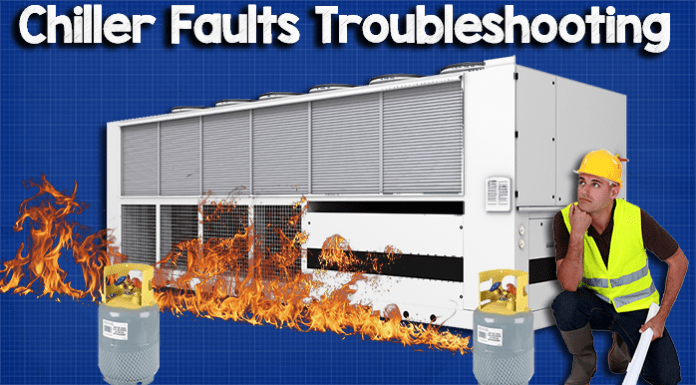



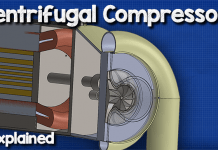
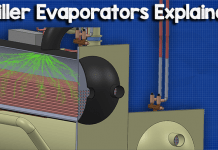
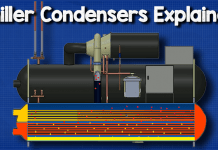
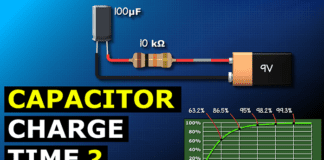
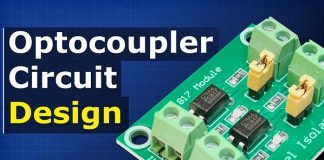

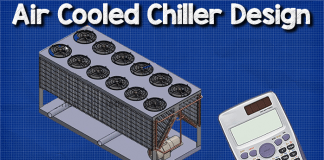
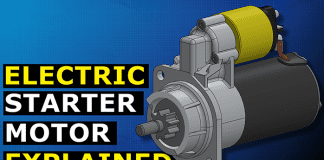
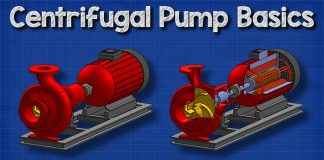








Nice insight
when the chiller design for summer what and where have to add to control system that chiller works safe on
fall . reguards
nice, and can be used as a reference article for future work.
a question:
what is the recommended best suction temperature to design the chiller?
i know this is very depending on the application and working conditions of the chiller. but as general role. and how to decide.
thanks
what do you mean by Circuit Unload in water cool scroll chiller?
can i turn back on the chiller unit when the relief valve for the condenser has been open..it was loud and scary at the moment but for few moment it stop..the water from the cooling towers was very hot causing it to release that high pressure..
My chiller model no. LCWX1-0385 Bluestar screw. There are only one problem (Low gas/LLS Fault). compressor running only 40 seconds, and show this alarm. I changed new expansion valve, PCO Controller, EKD and suction transducer whole system overhauling, but problem showing again and again. So please help me anybody my client is very angry with me. Where is problem tell me help me.
Are the slides in this video available to download?
I have one problem. In my site Voltas 60TR air cooled chiller unit’s come compressor sensor error. How to solve the problem plz kindly help me some one